Building Psychological Safety Guide for Thriving Teams 2025
In 2025, the most successful teams are not just defined by technical skills, but by a deep sense of trust and openness. The ability to speak up, share ideas, and learn from mistakes is what sets thriving organizations apart.
This guide delivers a clear, actionable roadmap for building psychological safety, empowering leaders and teams to reach new heights in performance and innovation. We’ll cover the science behind psychological safety, why it matters, the barriers teams face, and proven strategies to overcome them.
You’ll discover practical steps, real-world examples, and tools to measure and sustain a culture where everyone feels safe to contribute. For those seeking deeper transformation, resources like Accountability Now can support your journey.
Unlock your team’s full potential by prioritizing psychological safety—and be ready to lead with confidence in the future of work.
Understanding Psychological Safety: Definition, Science, and Impact
Psychological safety is the backbone of every high-performing team in 2025. At its core, it means team members collectively believe they can speak up, share ideas, and admit mistakes without fear of humiliation or punishment. Harvard professor Amy Edmondson coined this concept, highlighting that building psychological safety is not about comfort, but about creating an environment where candor and learning thrive.
What Is Psychological Safety?
Unlike simply being polite, building psychological safety is about honest dialogue and constructive challenge. It’s the confidence to ask tough questions, disagree respectfully, and learn from setbacks. Teams operating in psychologically safe environments embrace healthy conflict and see mistakes as chances to grow, not reasons for blame.
Psychological Safety vs. “Being Nice”
It’s a common misconception that psychological safety means lowering standards or avoiding hard conversations. In reality, it’s the opposite. Teams with high psychological safety hold each other accountable and push for excellence, but they do so by fostering trust, transparency, and a willingness to surface tough issues.
The Science Behind Psychological Safety
Extensive research supports the value of building psychological safety. Edmondson’s landmark studies showed that hospitals with higher psychological safety reported more errors—not because they made more mistakes, but because staff felt safe to report them. Gallup’s global surveys link psychological safety to higher engagement, while MIT has found toxic cultures drive turnover rates far more than pay. In fact, employees are ten times more likely to quit due to a negative environment than compensation. Three in four workers cite their boss as their top stressor.
For a deeper dive into the science and origins of psychological safety, see What is psychological safety?.
The Business Impact: Innovation, Retention, and Performance
Why focus on building psychological safety? Teams that feel safe to speak up consistently outperform those that do not. Research shows these teams innovate faster, collaborate more effectively, and adapt to change with agility. Organizations that prioritize psychological safety enjoy higher retention rates and increased employee wellbeing. According to recent data, companies that track and act on psychological safety metrics see measurable gains in engagement and lower turnover.
Real-World Examples
Google’s Project Aristotle famously found psychological safety was the top predictor of team effectiveness, outweighing even intelligence or skill. When teams feel safe, they are more likely to share bold ideas, challenge each other’s thinking, and recover quickly from setbacks. In the healthcare sector, teams with strong psychological safety deliver better patient outcomes because they surface and address risks early.
Psychological Safety in the Modern Workplace
Today’s hybrid and remote teams rely on building psychological safety more than ever. Distributed work increases the risk of isolation and miscommunication, making it essential to foster trust and openness intentionally. High psychological safety leads to better wellbeing, stronger retention, and greater adaptability during change.
Common Misconceptions
Remember, building psychological safety is not about being soft or avoiding accountability. It’s about creating the conditions for honest feedback, learning, and growth. Teams that get this right unlock extraordinary performance, resilience, and innovation—qualities every organization needs to thrive in 2025.
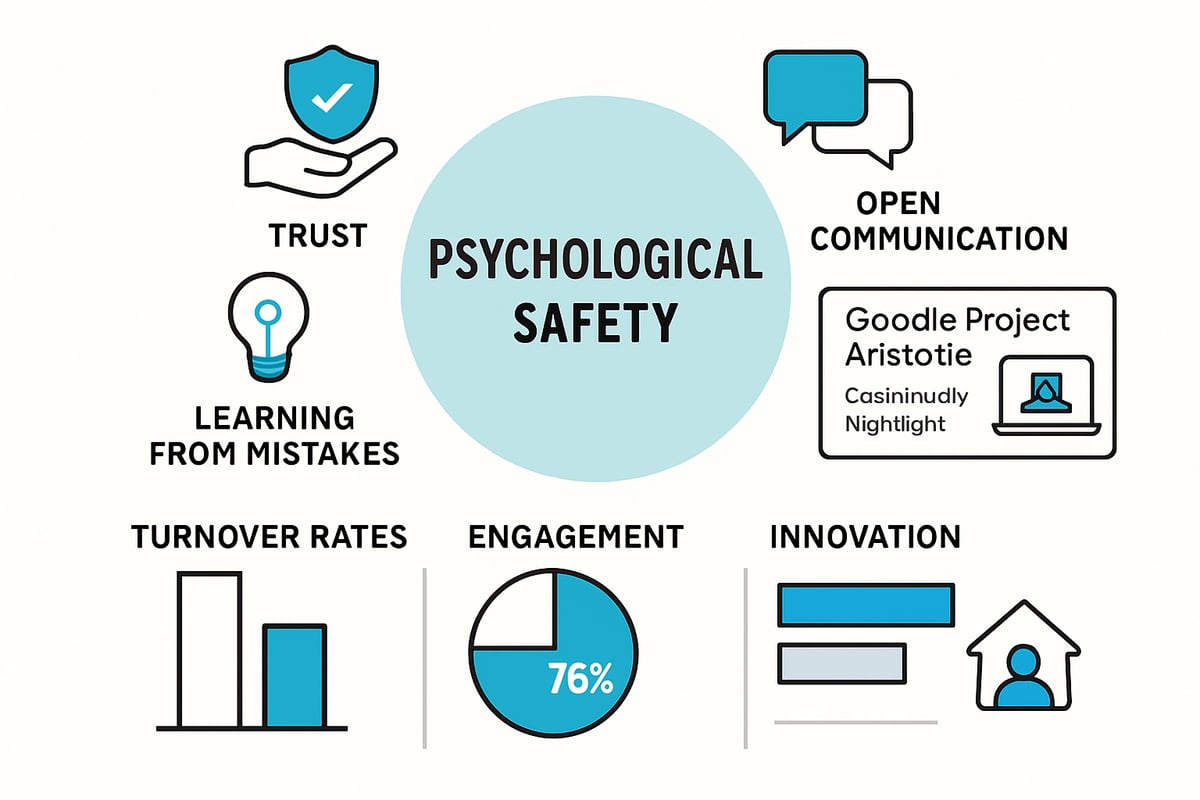
Barriers to Psychological Safety: Why Teams Struggle
Creating and maintaining psychological safety within teams is not as simple as setting a policy or running a workshop. Despite good intentions, many organizations struggle with building psychological safety due to deeply rooted workplace dynamics and human behaviors. Understanding these barriers is essential for any leader or team aiming to foster a truly open and high-performing environment.
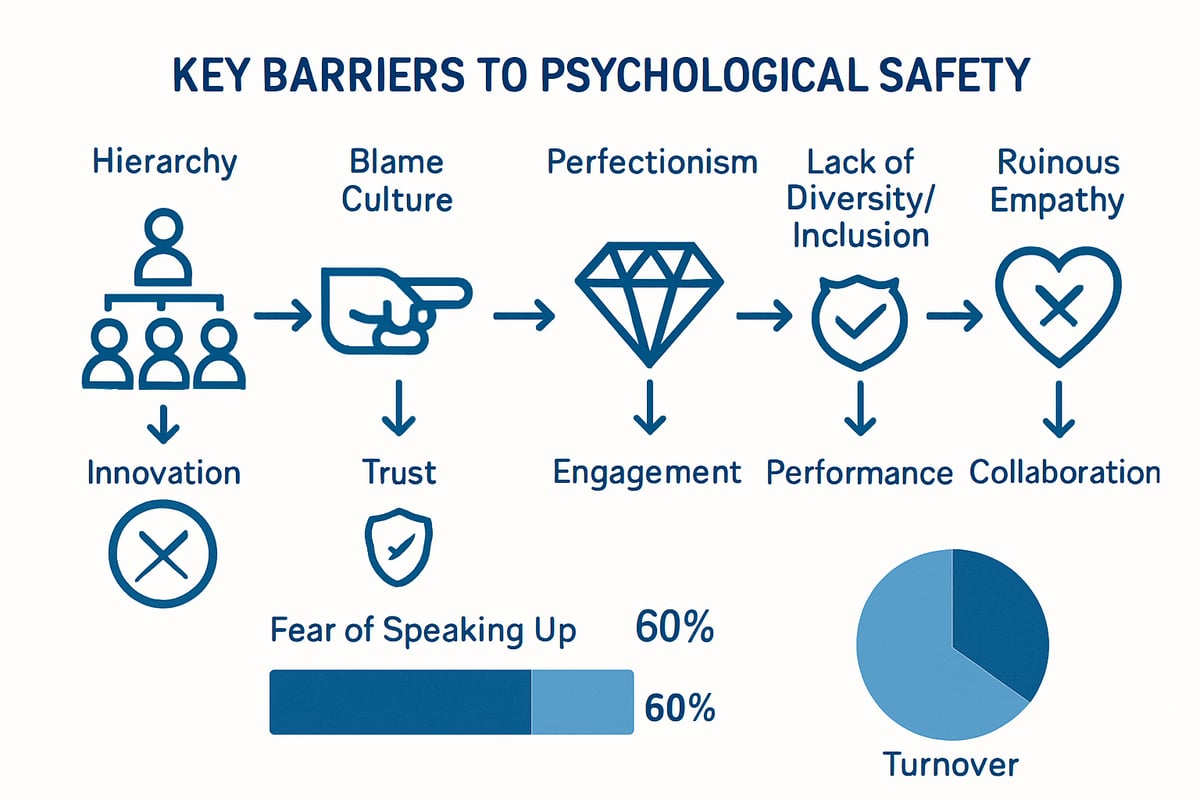
Common Obstacles in the Workplace
Hierarchical structures often prevent employees from speaking up, especially when they fear repercussions from those in authority. When team members worry about being judged or punished, they are less likely to share ideas, admit mistakes, or challenge the status quo. This fear is a major hurdle in building psychological safety and can quickly erode trust within the group. According to Psychological safety in the workplace, these power dynamics are among the most persistent challenges organizations face.
Blame Culture and Perfectionism
A culture focused on blame rather than learning discourages risk-taking and experimentation. When mistakes are met with criticism or punishment, employees learn to hide errors instead of using them as opportunities for growth. Perfectionism, especially when modeled by leaders who micromanage or react harshly, undermines building psychological safety even further. Teams become more concerned with avoiding failure than pursuing innovation.
The Role of Diversity, Inclusion, and Ruinous Empathy
Lack of diversity and cultural competence can prevent authentic participation. When team members do not see themselves represented or feel their perspectives are undervalued, they may withdraw or self-censor. Ruinous empathy, where leaders prioritize being nice over offering honest feedback, also damages building psychological safety. By avoiding difficult conversations, teams miss out on growth and improvement.
The Cost of Fear and Withheld Ideas
Research shows that many employees withhold ideas or concerns if they fear embarrassment or punishment. This silent disengagement stifles creativity and often leads to missed opportunities. Teams that avoid conflict or dissent tend to stagnate, unable to adapt or improve. A single negative incident, such as a dismissive comment from a leader, can quickly unravel months of progress in building psychological safety.
Fragility and Accountability
Psychological safety is fragile. It can be derailed by one careless remark or a breach of trust. This is why ongoing attention, open feedback, and accountability are crucial. Organizations like https://accountabilitynow.net/ emphasize the importance of consistent, transparent practices to sustain a culture where everyone feels safe to contribute. Addressing these barriers head-on is the foundation for building psychological safety that lasts.
The Leader’s Role: Modeling and Enabling Psychological Safety
Leaders are the architects of team culture. Their daily actions, words, and attitudes set the tone for what is possible within a group. At the core of building psychological safety is a leader’s ability to inspire trust and openness. Teams look to their leaders to know if it is truly safe to speak up, take risks, and challenge the status quo.
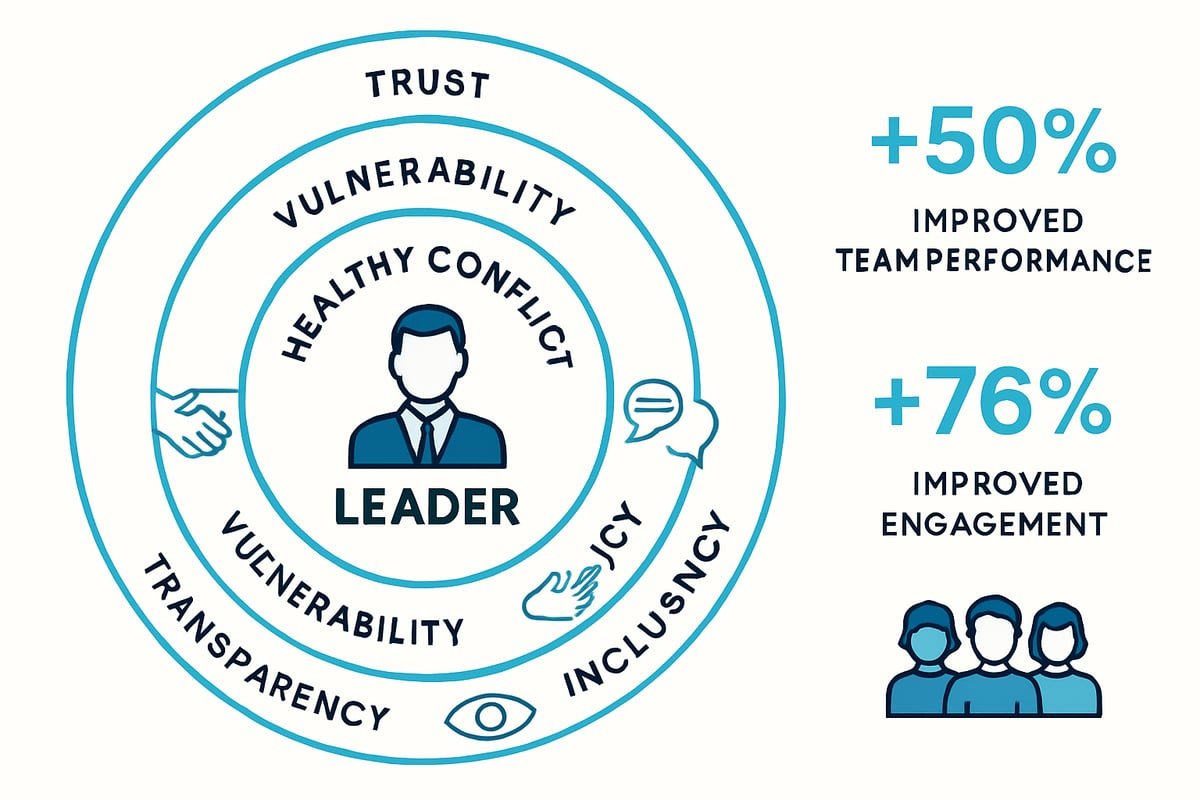
Leading with Vulnerability and Humanity
A cornerstone of building psychological safety is vulnerability. Leaders who admit their own mistakes or uncertainties pave the way for others to do the same. This openness is not a sign of weakness, but a powerful signal that learning is valued over perfection.
When leaders ask for feedback and genuinely listen, they break down barriers that stifle innovation. Sharing personal learning moments, or acknowledging when something could have been handled better, creates a climate where honesty is welcomed. The act of modeling vulnerability encourages every team member to contribute without fear of ridicule.
Fostering Healthy Conflict and Transparent Communication
Healthy conflict is essential for growth. Leaders must actively encourage respectful debate and constructive dissent. Rather than avoiding disagreements, effective leaders welcome diverse opinions and challenge groupthink.
Transparent communication is equally vital in building psychological safety. Leaders should openly share relevant information, explain the reasoning behind decisions, and ensure everyone understands the team’s direction. According to Amy Edmondson on psychological safety, teams thrive when leaders create an environment where candor is encouraged and mistakes are seen as learning opportunities.
Recognizing Contributions and Promoting Inclusion
Recognition is a powerful tool for building psychological safety. Regularly acknowledging individual and team achievements fosters a sense of belonging. Simple gestures such as public praise or a thank-you note can significantly boost morale.
Equally important is a commitment to diversity and inclusion. Leaders must actively seek out and champion different perspectives. By addressing bias and ensuring that all voices are heard, leaders create a culture where everyone feels valued. Inclusion is not just about representation, but about making sure every team member feels empowered to participate fully.
Table: Key Leadership Behaviors for Building Psychological Safety
| Behavior | Impact on Team |
|---|---|
| Admitting mistakes | Builds trust, models learning |
| Encouraging debate | Sparks innovation, prevents stagnation |
| Transparent decisions | Reduces uncertainty, builds clarity |
| Recognizing effort | Boosts engagement, fosters belonging |
| Championing diversity | Enables authentic participation |
Data, Real-World Example, and Reinforcement
Research consistently shows that managers who balance empathy with results drive higher engagement and performance. In fact, teams with strong psychological safety report lower turnover, greater innovation, and higher job satisfaction.
Consider the example of a leader who openly apologizes for not facilitating enough trust in the past. This act can reset team dynamics and signal a new commitment to building psychological safety. For organizations seeking practical frameworks, resources like Accountability Now offer actionable strategies to embed these behaviors.
Ultimately, building psychological safety is not a one-time task, but an ongoing commitment. Leaders who prioritize trust, vulnerability, healthy conflict, and inclusion enable their teams to adapt, thrive, and outperform.
Step-by-Step Guide: Building Psychological Safety in Teams
Creating a culture where everyone feels safe to contribute, challenge, and grow is not a one-off initiative. It takes consistent effort and clarity. Follow this proven, six-step framework for building psychological safety in your team, and unlock the full potential of every member.
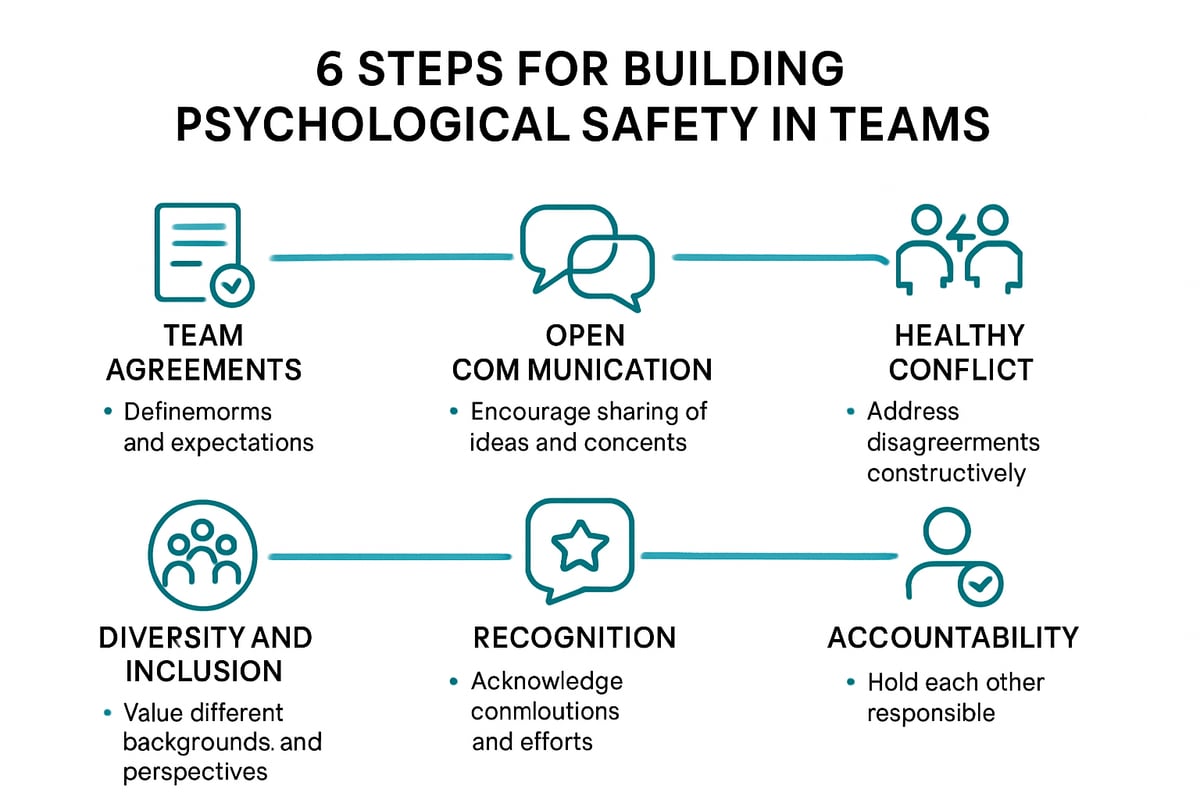
Step 1: Set the Foundation with Team Agreements
The first step in building psychological safety is co-creating clear team agreements. Gather your team and openly discuss what respectful communication, active listening, and constructive feedback look like in your context.
List out the following agreements:
- Speak with honesty and kindness.
- Listen without interrupting.
- Give feedback focused on behavior, not the person.
Invite every member to share their expectations and boundaries. Document these agreements and make them visible during meetings. Revisit and refine them regularly, as teams evolve and new challenges emerge.
Teams that consistently practice and update their agreements surface issues early and prevent misunderstandings. According to research, teams with explicit norms resolve conflicts faster and build trust more quickly.
For a deeper understanding of how teams progress, explore the Stages of psychological safety, which outlines the developmental journey teams follow. This knowledge can help you anticipate and address hurdles in building psychological safety from the start.
Step 2: Foster Open Communication and Vulnerability
Modeling vulnerability as a leader is crucial for building psychological safety. Admit when you are unsure or when you have made a mistake. This simple act signals to your team that it is safe to be human.
Encourage team members to ask questions and share concerns without fear of judgment. Establish regular check-ins and maintain an open-door policy, whether in-person or virtually. Use inclusive language, such as “What does everyone think?” or “I appreciate different perspectives,” to invite participation.
Avoid dismissive responses, even when ideas seem off track. Instead, ask clarifying questions to understand the reasoning behind suggestions. Leaders who share their own learning moments inspire others to do the same, reinforcing the message that growth is valued over perfection.
Open communication is the backbone of building psychological safety, especially in hybrid and remote environments where misunderstandings can easily occur. Make it a daily habit, not just a formal process.
Step 3: Encourage Healthy Conflict and Learning from Mistakes
Healthy conflict is a sign of a psychologically safe team. Building psychological safety means normalizing disagreement and debate as essential components of decision-making.
Shift the focus from “who made the mistake” to “what can we learn from this?” Implement blameless post-mortems after setbacks and retrospectives at the end of each project. These sessions should identify lessons learned, not assign blame.
Celebrate not only successes but also lessons gained from failures. This mindset reduces fear, increases risk-taking, and drives innovation. Teams that regularly engage in constructive conflict adapt faster and outperform those that avoid difficult conversations.
Consider using techniques like “failure parties” to share learnings openly, making it clear that mistakes are opportunities for team growth. Building psychological safety in this way ensures your team remains agile and resilient in a changing world.
Step 4: Promote Diversity, Equity, and Inclusion
Diversity, equity, and inclusion are foundational for building psychological safety. Ensure your team includes a mix of backgrounds, experiences, and perspectives.
Recognize and honor different communication and thinking styles, such as neurodiversity. Offer autonomy and flexibility in how people collaborate, like video-optional meetings or asynchronous brainstorming.
Actively check for unconscious bias in your interactions and decisions. Use anonymous surveys or suggestion boxes to capture voices that might otherwise go unheard. When everyone feels seen and valued, psychological safety flourishes.
Teams that embrace diversity report higher psychological safety and deliver better results. Incorporate DEI into your team rituals and review processes to sustain this progress. Building psychological safety is inseparable from building an inclusive culture.
Step 5: Recognize, Celebrate, and Support Individuals
Consistent recognition is a powerful tool for building psychological safety. Regularly acknowledge both individual and team contributions, big or small.
Create simple rituals, such as appreciation circles or “shout-outs” at the start of meetings. Support your team’s mental health and wellbeing by providing resources, flexible work options, and genuine check-ins.
Even small gestures of recognition can boost belonging and engagement. When people feel appreciated, they are more likely to contribute ideas and take positive risks. Building psychological safety means making appreciation part of your team’s DNA.
Step 6: Maintain Accountability and Continuous Improvement
Accountability and continuous improvement are vital for sustaining building psychological safety over time. Hold regular feedback sessions and use pulse surveys to gauge how safe people feel in your team.
Set measurable goals for team culture, such as increasing participation in meetings or reducing turnover. Address issues as soon as they arise, and be transparent about what actions are being taken.
Iterate on your strategies as your team grows and external factors change. Organizations that measure and act on psychological safety data see lasting improvements in performance, adaptability, and retention. For additional tools and resources, visit Accountability Now for practical frameworks.
Building psychological safety is an ongoing journey. By embedding these steps into your team’s daily rhythms, you create an environment where everyone can thrive.
Practical Exercises and Activities to Build Psychological Safety
Practical exercises are the backbone of building psychological safety in any team. These hands-on activities move theory into action, helping teams create habits that foster openness, trust, and courage to speak up.
Core Exercises for Building Psychological Safety
- Failure Parties: Celebrate mistakes as learning opportunities. Teams come together to share recent failures, discuss what was learned, and remove the stigma from getting things wrong.
- Blameless Post-Mortems: After a project or incident, the team reviews what happened without assigning blame. The focus is on process improvement and collective learning, which is crucial for building psychological safety.
- Courageous Conversations: Schedule regular sessions where team members practice giving and receiving feedback on tough topics. This builds resilience and helps normalize healthy conflict.
- Story-Sharing Rounds: Invite everyone to share a story about a time they took a risk or learned from a setback. This encourages vulnerability and connection.
- Peer Appreciation Circles: Allocate time for team members to recognize each other’s efforts. Public appreciation strengthens trust and a sense of belonging.
- Rotating Meeting Facilitators: Give every team member the chance to lead meetings. This distributes power, encourages diverse voices, and signals shared responsibility for building psychological safety.
- Icebreakers and Role-Play: Use scenario-based activities to practice difficult conversations or introduce new members. These exercises lower barriers and make it safer to speak up.
- Anonymous Suggestion Boxes: Provide digital or physical spaces for team members to share ideas and concerns without fear of judgment.
Consistent use of these activities creates a rhythm of openness. Teams that integrate these exercises into their routines report higher engagement and adaptability.
Evidence and Impact
Research consistently shows that teams practicing these methods see measurable improvements. For example, the Psychological Safety and Team Performance Study found that regular learning behaviors and open communication directly correlate with better team outcomes and innovation.
Teams that prioritize building psychological safety are more likely to surface issues early, adapt quickly to change, and retain top talent. For organizations looking to deepen their approach, additional strategies are available at accountabilitynow.net.
Building psychological safety is not a one-time effort. The key is to embed these exercises into daily and weekly routines. Over time, trust grows, collaboration deepens, and the team’s collective intelligence rises.
Measuring and Sustaining Psychological Safety in 2025
Tracking progress is essential for building psychological safety that lasts. In 2025, organizations cannot afford to rely on gut feelings or anecdotal evidence alone. Instead, high-performing teams use clear indicators to measure psychological safety, ensuring it becomes a living part of their culture.
Key Metrics and Tools for Building Psychological Safety
To measure building psychological safety, start with quantifiable metrics. These include employee engagement scores, voluntary turnover rates, innovation benchmarks, and results from psychological safety surveys. Research shows that teams who consistently monitor these metrics outperform their peers in adaptability and resilience.
Some of the most effective tools for measurement are:
| Tool/Framework | What It Measures | Frequency |
|---|---|---|
| Edmondson’s Team Survey | Interpersonal risk-taking, trust | Quarterly |
| Pulse Checks | Real-time sentiment, engagement | Monthly |
| 360-Degree Feedback | Leader and peer behaviors | Biannual |
| Innovation Metrics | Number of new ideas, experiments | Ongoing |
According to Psychological Safety Statistics 2025, organizations that prioritize these tools see up to 30 percent higher engagement, and their teams are twice as likely to retain top talent.
Embedding Psychological Safety in Culture
Building psychological safety is not a one-time event. Integrate it into performance reviews, leadership development, and onboarding processes. Make it a standing agenda item in team meetings and set measurable goals for team culture.
Leaders should use survey results to spark open discussions, identify barriers, and co-create solutions. Training and coaching play a pivotal role in helping managers translate feedback into action. Embedding psychological safety in daily routines sends a clear message that it is a core value, not an afterthought.
Organizations that align their measurement practices with evolving standards—such as the Workplace Psychological Safety Act—are better prepared for regulatory changes. They also build a foundation for innovation, wellbeing, and long-term success.
Sustaining Momentum and Accountability
Sustaining building psychological safety requires ongoing commitment. Regularly review progress using pulse surveys and feedback loops. Establish accountability by sharing results transparently and following up with concrete actions.
Companies that embed psychological safety into their leadership pipelines and training programs see sustained improvements, even during periods of change. For example, by leveraging best practices from resources like Accountability Now, organizations can boost resilience and respond quickly to setbacks.
A culture of psychological safety is not static—it evolves with your people and business needs. Prioritize continuous improvement, celebrate progress, and make psychological safety a visible part of your strategic vision.
The Future of Psychological Safety: Trends and Predictions for Thriving Teams
The future of building psychological safety is rapidly shifting, as teams adapt to new work realities and emerging challenges. In 2025, organizations that prioritize psychological safety will stand apart, creating environments where people feel secure, valued, and empowered to innovate.
The Hybrid and Remote Revolution
Hybrid and remote work models are now the norm, not the exception. This shift brings new opportunities and challenges for building psychological safety across distributed teams.
Leaders must foster trust and inclusion without the benefit of daily face-to-face interactions. Virtual spaces demand intentional strategies for connection and open communication. Mental health and belonging are now core business priorities, as employees seek meaningful engagement regardless of location.
Forward-thinking organizations embed building psychological safety into their onboarding, collaboration, and feedback processes. Teams that do so report higher resilience, adaptability, and retention.
Digital Tools and Data-Driven Cultures
AI-driven tools are transforming how teams monitor, measure, and nurture psychological safety. Real-time feedback platforms and sentiment analysis help leaders identify issues early and respond with agility.
Compliance standards are also evolving, with new regulations requiring organizations to track and report on culture, safety, and wellbeing. By leveraging digital platforms and analytics, organizations can ensure that building psychological safety is not just a value, but a measurable outcome.
Data shows that teams using these tools experience faster recovery from setbacks and sustained innovation. Diverse perspectives are amplified when technology bridges gaps, driving better performance. For more insights, explore the relationship between psychological safety, diversity, and team performance.
Leadership Skills and Regulatory Shifts
Leadership in 2025 demands empathy, adaptability, and inclusive decision-making. Building psychological safety requires leaders to model vulnerability, champion diversity, and align team goals with organizational values.
Regulatory frameworks are expanding, making psychological safety a compliance issue as well as a cultural imperative. Leaders must stay up to date on best practices and legal requirements, integrating psychological safety into every layer of the organization.
Continuous learning and leadership development are essential. Companies investing in coaching and accountability, such as those highlighted by Accountability Now, are future-proofing their cultures and unlocking higher performance. As research continues to link psychological safety with innovation and market success, building psychological safety will remain a cornerstone of thriving teams.

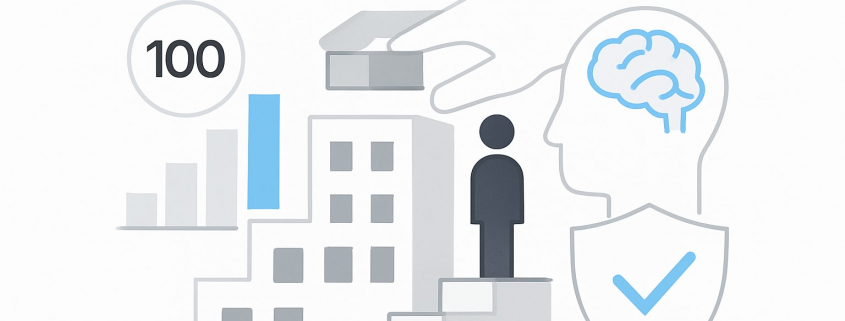


Leave a Reply
Want to join the discussion?Feel free to contribute!